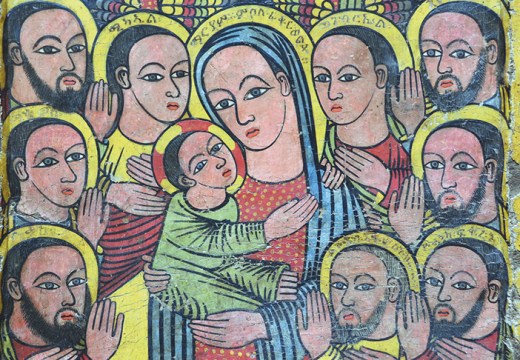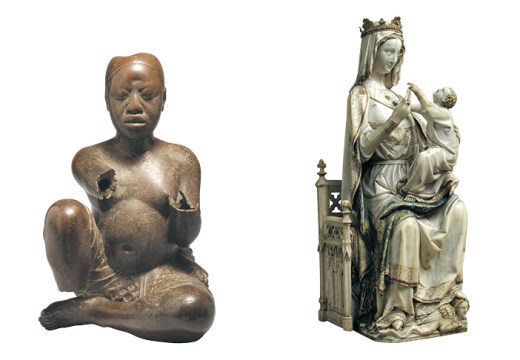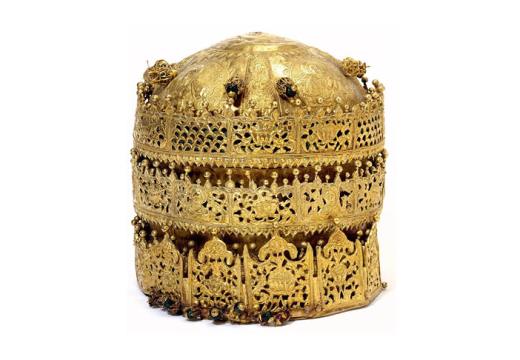From the January 2024 issue of Apollo. Preview and subscribe here.
Christine Sciacca of the Walters Art Museum unfolds the origins of an Ethiopian processional icon of surprisingly modern design.
During the 15th century many of the monasteries of Ethiopia were found in the highlands, in the region of Tigray. They are renowned for being built into cliffs, in a way redolent of Mount Athos in Greece. One of the most important is Gunda Gunde monastery, also known as Dabra Garzen, which lies at the base of one of these types of mountains and was carved directly into the living rock, on the border of Ethiopia and Eritrea. It was founded by the popular monk Abba Estifanos. Despite its relative inaccessibility, people seem to have made it there and this seclusion may explain why so many unusual experiments in parchment happened at this monastery. Of course, they produced codices, but we have also found several sensul or ‘chained’ manuscripts (where one horizontal strip of parchment is attached to boards at each end and accordion folded many times to create a book that is eight to 10cm square, or larger, and about 1cm thick when it is closed) – many of the early examples that we know come from Gunda Gunde. But one of the most impressive examples of an unusual manuscript is this 15th-century processional fan, made from six pieces of parchment stitched together. Only about six of these survive from the Middle Ages in Ethiopia. This is the only one of its age in a collection outside Ethiopia.
There were two kinds of monastic movement in Ethiopia during the 15th and 16th centuries, one of which was founded by Estifanos. He was considered a dissident by the emperor of Ethiopia, Zara Yaeqob (r. 1434–68) who as a proponent of the cult of Mary signalled his involvement in religion by a decree that every church should have an icon of her. There were certainly images of Mary before this decree, but he made it a requirement that every church had to carry one. Estifanos spoke out against the emperor’s promotion of this cult and was exiled – Yaeqob went so far as to call the followers of Estifanos enemies of Mary. This is slightly paradoxical, since this monastery produced some of the most incredible images of Mary in manuscript form that you will see from Ethiopia. But as we know, what is actually documented in the historical records can be very different from reality.
There are two women on the fan, one of whom is Mary. She is right at the centre, so when the fan is opened out she appears at its apex. All of the male figures are haloed, indicating that they are some sort of saint or apostle. Only a few of the central figures have inscriptions over their heads that identify them. The others appear to be generic holy people. The figures on either side of the Virgin Mary are the archangels Gabriel and Raphael. In an Ethiopian context, in both icons and manuscripts, you frequently see the archangels holding drawn swords, so they become a sort of honour guard for Mary. They appear to be protecting her.
The fan would be folded round into a complete circle and the boards would be pinned at the bottom, a little like a child’s toy fan. The fan would be then held up as part of a procession, the figures on the parchment leading the men on the ground. Today, so many of the feast days in Ethiopia, in the Christian church, have a procession around the church building as part of the ceremony, with processional crosses and maybe something like this processional fan, and with umbrellas, especially over the priests. The main priests will carry replicas of the tabot, the two tablets of the Ark of the Covenant, essentially on their head; this fan operates as another icon of Mary.
All of the male figure are haloed, indicating that they are either saints or apostles
When the fan was made, this sort of illustration had existed in Ethiopia for at least 100 years. There was an extraordinary production of manuscripts around this time. The earliest manuscripts in Ethiopia date to the 14th century. Before that, there was certainly wall painting, which established a painting tradition. Wall paintings were an essential part of Ethiopian religious architecture, and are where the traditions of Ethiopian painting are most obvious. As the church form evolved in Ethiopia, they started to build circular churches, with a central sanctuary called the maqdas, which only the priests could enter. The outside walls of the sanctuary would be painted and there would be an aisle around it, so the paintings were almost exposed to the elements. Many of these wall paintings that still survive today, especially from the last few hundred years, have been renewed and restored, or the old ones have been taken down and new ones put up. As you get into the 15th century, there is this development of icons on wood panel, in part because Zara Yaeqob required this of every church.
The processional icon unfolded to its full extent. It was originally designed to be folded into a circle with its two ends pinned together
When I see objects in parchment that are not in book form, that tells me that they are they are being creative with that process – you really don’t see these kinds of objects elsewhere. Looking at the fan when it is all stretched out, it’s very impressive. When you look down the length of it, you see that it looks like figures in procession: it is almost like the object is evoking its own use. If you look at it head on, you find that the figures in the valleys are paired and are actually in conversation with each other. They face inward towards each other – all the figures the recto side of the fold are looking one way, and all the ones on the verso of the folds are looking the other way. This can either be a conversation or a procession. There’s a bit of variation in the dress, and the colour, and the hand positions. A few of them are holding books or something of that sort. There is a real rhythm to the figures as you look at them. This patterning and rhythm is not uncommon – for example, there’s a manuscript from the Getty Museum in the exhibition, which is a codex, but you have the figures all lined up in a row, a whole row of saints, and then you turn the page and there’s another two pages, a double-page spread of rows of saints. It is very graphic; it is very modern. But this rhythm, I think, is coming from the processional tradition in the Ethiopian Orthodox Church.
The technique we see to prepare this parchment is pretty standard, be it in Europe or in other places. The skin has been treated to receive pigment – obviously, the hair has been removed and all that sort of thing. But the Ethiopian parchment-making process is a bit different than in Europe. The skin is not soaked in lime, it is just washed with water. It actually has a slightly different scent than Western parchment would. We worked with the Institute of Digital Archaeology in England, who have worked with scholars at Oxford University to reproduce scents from various things. They developed a scent of Ethiopian manuscripts for an exhibition at the Bodleian Library. We are borrowing some of our own manuscript scent from them for the exhibition ‘Ethiopia at the Crossroads’ (until 3 March).
We carried out further analysis regarding the type of parchment. The problem with Ethiopian art is that a lot of things have been assumed, or if one person says, ‘They used goatskin for manuscripts’ then every other piece of literature afterwards says Ethiopians use goatskin. But no one has actually analysed this. Abigail Quandt, head of book and paper conservation at the Walters, worked with Dr Sarah Fiddyment at the University of Cambridge, in a process similar to DNA analysis, a protein analysis. They can analyse particles of the parchment to identify what kind of animal the skin came from. Many of the Ethiopian parchments in our collection were on goat, but we also had some on sheepskin, and we have one manuscript, also from Gunda Gunde and from roughly the same period as this fan, which is actually calfskin, so a very high-quality parchment.
The parchment is attached to boards at each end and then accordion-folded to create a book
Once the parchment was prepared the artist would prepare the pigments. They could use mineral pigments or organic pigments. The basic designs of these figures were drawn using not the more traditional iron gall for a black outline but indigo, which was imported into Ethiopia at the time, likely from India.
While indigo is not quite as expensive as lapis lazuli from Afghanistan, it would still have been an expensive material to use. But it also shows that Ethiopia was not isolated. In fact, such activities show just how well-connected Ethiopia was. There were certainly trade routes going through the country, with lots of exchanges along the way.
The outline of the figures was then painted over. The Ethiopian palette is relatively limited; especially early on, it is basically the colours of the Ethiopian flag. There is obviously a long history of these colours in Ethiopia: reds, oranges, yellow, green, sometimes blue. That is the basic idea of how these figures were drawn, and then each figure is built up by the artist. It is a style that was very particular to Gunda Gunde.
Obviously, if you keep opening and closing parchment like this, it is going to disintegrate over time. This example is actually fairly well preserved. But you can see why, if there were more of these, they would have not survived repeated folding and, eventually, just disintegrated.
As told to Edward Behrens.
‘Ethiopia at the Crossroads’ is at the Walters Art Museum, Baltimore, until 3 March.
From the January 2024 issue of Apollo. Preview and subscribe here.
Unlimited access from just $16 every 3 months
Subscribe to get unlimited and exclusive access to the top art stories, interviews and exhibition reviews.













![Masterpiece [Re]discovery 2022. Photo: Ben Fisher Photography, courtesy of Masterpiece London](http://www.apollo-magazine.com/wp-content/uploads/2022/07/MPL2022_4263.jpg)
It’s time for the government of London to return to its rightful home